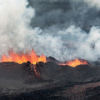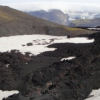
EAG Photo Contest: last days to vote
The jury has selected the best 5 photos in each of the three themes and we now invite you to vote for your favourite photos. Deadline for online voting is 20 September.

The jury has selected the best 5 photos in each of the three themes and we now invite you to vote for your favourite photos. Deadline for online voting is 20 September.

If you know of scientists who merit recognition, please take a few minutes to nominate them for an EAG Award or for the EAG-GS Fellowship. The process is simple and the various awards recognize scientists at different stages of their career:
Please send your nomination before 31 October for EAG-GS Fellows and before 15 November for all other awards.

The EAG Distinguished Lecture Program aims to introduce and motivate scientists and students located in under-represented regions of the world to emerging research areas in geochemistry. This year's Distinguished Lecturer, Dr. Rachael James, University of Southampton, will be visiting the following locations:
You can find lecture abstracts here. Lectures are open to all so if you are a nearby location, do not hesitate to attend.

Several grants of up to 200 Euros are still available for students wishing to attend a short course or conference taking place in Europe before 1 March 2015. Find out all the details.

[By Jan Prikryl] It is Wednesday morning. I arrive at my office at the University of Iceland after the International Carbon Conference in Reykjavík and quick visit to Oslo. In the hallway I am already going over my to do list in my mind. The first person I meet is Nicole, calling: “We are flying to the eruption! Andri and Siggi booked the plane!” Read more
Also see 11 stunning photos of Bárðarbunga Volcano.

[By Chris Pearce] Global media attention was drawn to Iceland last week when days of increased seismic activity around Bárðarbunga culminated in the spectacular fissure eruption in the Holuhraun lava field. Just a few hours before this eruption started I and about 80 other geologists were standing next to a similar fissure site that marked the start of the 2010 eruption sequence at Eyjafjallajökull. Read more

[By María Chapela Lara, Daniella Rempe and George Giannakis] Thanks to the support from the EAG I was able to attend the Geohemistry of the Earth's Surface 10 conference, a tri-annual meeting that is part of the activities of the Geochemistry of the Earth Surface working group of the International Association of Geochemistry (IAGC). This year the meeting was held in Paris (August 18-22th), organized by the Institut de Physique du Globe de Paris. The GES-10 conference was placed under the banner of the Critical Zone, the layer of the earth that goes from the aquifers to the top of the tree canopy... Read more

[BBC News] Scientists and engineers have spent weeks studying the 4km-wide "ice mountain" known as 67P, looking for a location they can place a small robot. They have chosen what they hope is a relatively smooth region on the smaller of the comet's two lobes. But the team is under no illusions as to how difficult the task will be. Read more
Also see European Space Agency article.

[Science Daily] World leaders face multiple barriers in their efforts to reach agreement on greenhouse gas emission policies. And, according to Arizona State University researchers, without globally consistent, independent emissions assessments, climate agreements will remain burdened by errors, self-reporting, and the inability to verify emissions progress. Read more

[Science Daily] Tiny single-cell organisms discovered living underground could help with the problem of nuclear waste disposal, say researchers involved in a study at The University of Manchester. Although bacteria with waste-eating properties have been discovered in relatively pristine soils before, this is the first time that microbes that can survive in the very harsh conditions expected in radioactive waste disposal sites have been found. Read more

[BBC News] A small meteorite landed near the international airport in the Nicaraguan capital, Managua, on Saturday night, government officials say. Residents reported hearing a loud bang and feeling the impact, which left a crater 12m (40ft) wide and 5m deep. Read more

[Horizon 2020] An EU-funded project has demonstrated technology to shorten the time carbon takes to mineralise underground – from thousands of years down to a few. Storing captured CO2 underground is made safer – opening the door to its wider use in preventing global warming. Read more

Receive job ads as they are posted: like us on Facebook or follow us on Twitter (@EAG_). Post a position on the EAG job page (free of charge): send the details to EAG Office.
More jobs at www.eag.eu.com/jobs.
Thank you for your attention!
